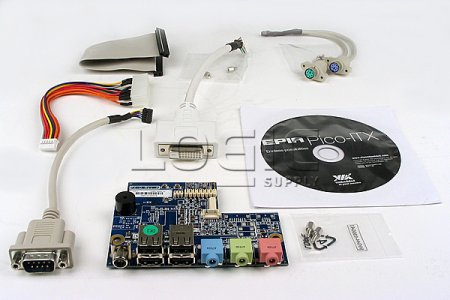Pico-ITX board tests well, except for HD media
Jun 5, 2007 — by LinuxDevices Staff — from the LinuxDevices Archive — 5 views The first of Via's Pico-ITX boards is delightfully small, cool-running, and quiet, while offering DVI-D and a stacked I/O add-on board. However, driver problems under both Linux and Windows prevent the PX-1000 from delivering satisfying high-definition video, according to a review at… Mini-ITX.com.
The first of Via's Pico-ITX boards is delightfully small, cool-running, and quiet, while offering DVI-D and a stacked I/O add-on board. However, driver problems under both Linux and Windows prevent the PX-1000 from delivering satisfying high-definition video, according to a review at… Mini-ITX.com.
The PX-1000 is the first shipping board in Via's new Pico-ITX line, It measures 3.9 x 2.8 inches (100 x 72mm), and offers all its I/O on pin headers, except for rear-panel RJ-45 and VGA ports.

The PX-1000 comes with a PX-O I/O board and several cables
(Source: Logic Supply. Click to enlarge)
Additionally, the PX-1000 comes with a PX-O I/O board (depicted above) that attaches to three of its board-to-board connectors. The I/O board increases the total dimensions to 4 x 5 inches (100 x 128mm), while adding three 1/8th-inch stereo mini-plugs software configurable as 6-channel audio outs, or as stereo audio I/O; 4 x USB 2.0 ports; and an RCA connector of an unspecified nature (possibly TV out). Additionally, the I/O board includes a buzzer, and passes through the PX-1000's PS/2 connectors and front-panel connector.

The PX-1000 and PX-O I/O board
(Source: Mini-ITX.com)
In benchmark testing at Mini-ITX.com, the PX-1000 performed pretty well, turning in mostly mid-pack performances when matched against Via nano-ITX and mini-ITX boards clocked the same or faster. It took about twice as long as a modern AMD or Intel chip to encode a WAV into MP3 format, however. In fairness, power consumption hovered between 14 and 16 Watts, while current AMD and Intel chips use closer to 45 Watts. The PX-1000 may also run quieter; it's “fansink” produced barely more noise than a hard disk drive, the review suggests.
The PX-1000 is the second Via board, after the EX1500/EX1000 mini-ITX board, to feature digital video out. Both are marketed as offering hardware acceleration for high-definition (720p) video. However, mini-ITX discovered in its testing what numerous forum posts from EX1500 users suggest — that the boards' high-definition features may be difficult or impossible to get working.
Under Windows, the trouble seems to be that Via's drivers do not include codecs for formats other than MPEG-2 (used in DVD playback). Windows users wishing to render HD video on their PX-1000 boards must therefore purchase third-party software just to get codecs that, in turn, may or may not work, the mini-ITX review suggests.
On the Linux side, the picture appears even worse. The mini-ITX reviewer reported spending two late nights attempting to follow “meandering” documentation about how to install Via's proprietary video drivers, only to fall short. “Most people aren't Alan Cox — this needs to be made as simple as possible,” he or she concludes.
Still, the reviewer notes that high-definition media playback is not the PX-1000's only target use. Open source Xorg video drivers should work well enough on the board for all but the most aggressive media and 3D processing applications.
The review generally praises the board for its size, efficiency, and processing power. It concludes, “In a month or two [when the PX-1000 is widely available], the average punter will be able to do things that only people with access to industrial boards could do [in the past].”
The full Mini-ITX review can be found here.
This article was originally published on LinuxDevices.com and has been donated to the open source community by QuinStreet Inc. Please visit LinuxToday.com for up-to-date news and articles about Linux and open source.